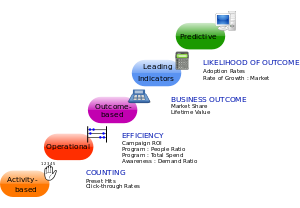 |
| Image via Wikipedia |
The rules and practices, defined by the XP methodology, if followed by content marketers and their customers, will ensure that the project can easily adapt to changing requirements, at any time during the project life cycle. This results in a more cost effective and efficient project, creating a quality product.
Objectives
The main objectives behind the XP Methodology are:
¶ Greater customer satisfaction, promoting teamwork among project members, i.e., content marketers and customers.
¶ Delivery of high quality products, reducing costs and efforts required to handle change requests.
Principles
The XP methodology builds on four principles that ensure adaptability in the development process:
¶ Communication: The XP principle of communication states that all individuals involved in the project should communicate and discuss the project requirements thereby ensuring that the views of the marketers, regarding requirements match those of the customers.
¶ Simplicity: The principle of simplicity states that design and development of the project should be kept simple. The design should be such that it meets only present needs.
¶ Feedback: The feedback principle states that constant feedback in terms of tests and customer responses make for better development.
¶ Courage: The principles of communication, simplicity and feedback provide content marketers with the courage to work in such a manner to respond to changing requirements.
In XP, extensive tests are written, ensuring that no flaws/bugs are present in the product. The project is released to customers in small iterations (according to current requirements), enabling the customer to test the work product against present requirements. Customer feedback and changes are easily implemented into the work product.
In XP, extensive tests are written, ensuring that no flaws/bugs are present in the product. The project is released to customers in small iterations (according to current requirements), enabling the customer to test the work product against present requirements. Customer feedback and changes are easily implemented into the work product.
Practices
The rules and practices propounded in the XP Methodology are:
Planning — The planning process involves the following:
¶ Creating user stories, i.e., broad descriptions of each feature required by the customers;
¶ Estimating time required by the content writers to develop each story;
¶ Creating a release plan that defines the project schedule; and
¶ Dividing the project into small iterations.
At the start of every iteration there is a planning meeting. The customer selects user stories that are to be developed in the iteration. The user tests are then broken down into working tasks. The marketers and writers estimate the time required for each task. Each iteration last up to 3 weeks.
Designing — The practice of designing involves the following steps:
At the start of every iteration there is a planning meeting. The customer selects user stories that are to be developed in the iteration. The user tests are then broken down into working tasks. The marketers and writers estimate the time required for each task. Each iteration last up to 3 weeks.
Designing — The practice of designing involves the following steps:
¶ The design should be as simple as possible. The design should be such that it only caters to current requirements.
¶ Consistent naming conventions are followed to enable content re-use and for better understanding.
¶ Constant changes to the content to remove redundant and unused functionality thereby improving content quality.
¶ The content should be uncluttered, i.e., it will not contain content not required in the current release.
Marketing — The following rules are followed under the marketing process:
Marketing — The following rules are followed under the marketing process:
¶ Before beginning, content marketers are required to create tests that help them understand the requirements and enable them to get immediate feedback on the content written;
¶ Writing and editing should be done according to standards thereby making it easier to understand and adapt;
¶ All content needs to be reviewed sequentially and at regular intervals; and
¶ All development is to be done within the time-lines defined, no overtime is allowed.
Testing — The testing practice must follow the rules mentioned below:
Testing — The testing practice must follow the rules mentioned below:
¶ All content must have associated tests that ensure its functionality;
¶ Content can be released only after it clears all the associated tests; and
¶ Acceptance tests should be created to test the content against the user story for flaws.
Acceptance tests verify that the user story being developed is being correctly implemented. After the content has passed the acceptance tests, the user story is considered complete and is released to the customer.
Applications
The XP methodology is ideally suited for the following types of projects:
¶ Projects where the requirements and functionality are expected to change frequently such as with research projects and new technologies.
¶ Projects where the number of marketers is fewer.
Following these practices and principles on a day-to-day basis ensures a development process that successfully meets the objectives of XP.
These practices make for a greater availability for projects and higher quality work products. At Zen Content & Social Marketing Management, I offer XP benefits by adopting the agile practices outlined above.
Following these practices and principles on a day-to-day basis ensures a development process that successfully meets the objectives of XP.
These practices make for a greater availability for projects and higher quality work products. At Zen Content & Social Marketing Management, I offer XP benefits by adopting the agile practices outlined above.

No comments:
Post a Comment